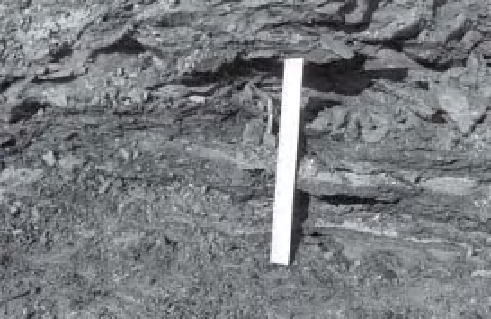Geoscience Reference
In-Depth Information
et al. 1998). Modern-day equivalents to this
amber tree resemble Kauri pine (
Agathis aus-
tralis
), monkey puzzle (
Araucaria araucana
),
and Norfolk Island pine (
A. heterophylla
), which
occur primarily in the southern hemisphere.
Tertiary amber from the Baltic region, known
as succinite, is the most abundant amber in
the world. The depositional environment of
the Baltic amber, according to Kosmowska-
Ceranowicz (2009), included an ancient River
Eridanus, which ended at the Eocene Sea and
created a delta in the vicinity of northern Poland
and Kaliningrad, Russia. The identity of the
Baltic amber tree is still being debated with
several contenders (Szwedo and Szadziewski
2009), but it is accepted that the amber trees
grew in wetlands such as swamps and lowland
forests (Greb, DiMichele and Gastaldo 2006).
Preserved insects, spiders, and other small
animals including larvae of caddisl ies, mayl ies,
and water bugs suggest standing water in the
ancient swamps (Larsson 1978).
Less controversy surrounds the amber tree in
the Dominican Republic and Mexico. These
ambers derive from an “algarrobo forest,” and
the extinct species
Hymenaea protera
(Poinar
1995, 1999; Corday and Dittrich 2009). This
species resembles the present
Hymenaea,
which
is closely related to the modern algarrobo or
carob tree, and
Hymenaea verrucosa
Gaertner,
known as the East African Copal (Poinar 1992;
Huber and Langenheim 1986). In general,
Dominican and Mexican ambers contain more
l oral and faunal inclusions than does Baltic
amber, including small l ies such as midges and
mosquitos, marsh beetles, mayl ies, water strid-
ers and caddisl ies; all of which lived in wetlands
such as ponds, rivers, intertidal mudl ats, and
shorelines (Poinar and Poinar 1999). The i rst
anopheline mosquito is preserved in Dominican
amber, signaling that these potential malaria-
carrying vectors were present in Neogene times.
Primary sources of amber are mainly Creta-
ceous coal and Tertiary lignite deposits; however,
quite often amber is eroded from these parent
sources and redeposited into younger sedimen-
tary strata. For example, ambers from the
Ukraine and the Bitterfeld region in Germany
are found in Miocene sediment, yet have similar
A
B
Figure 9-8.
North Carolina amber. A. Lignite and clay
beds in the Cape Fear Formation (Cretaceous) from
which the amber was recovered. Scale is 12 inches
(30 cm) long. B. Amber specimens in matrix;
∼
4 inches
across. Photos courtesy of V. Krynicki.
Tertiary amber comes from many locations
including Australia (Bickel 2009; Hand et al.
2010), but the most abundant Tertiary amber is
from the Baltic region of central Europe, the
Dominican Republic and Mexico. Regardless of
locations, identifying the origin of the resin or
the amber-producing tree may be a puzzle,
because chemical studies are not corroborated
by l ora inclusions, and amber tree descendants
occur in different geographic areas. For example,
it is often suggested that the most common
amber trees were araucarian (family Araucar-
iaceae) in origin; however, pine cones, needles,
and wood fragments are missing from Baltic
amber (Engel 2001), and these gymnosperms
are no longer abundant in the northern hemi-
sphere where the amber is found (Setoguchi






